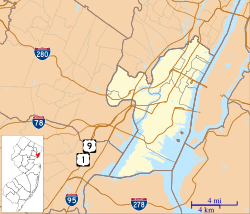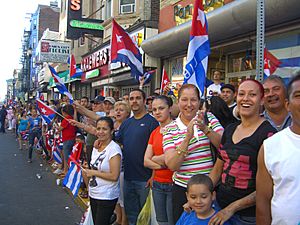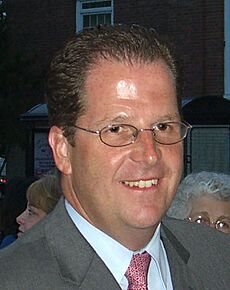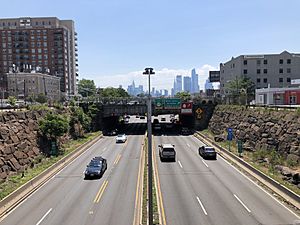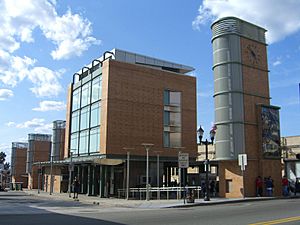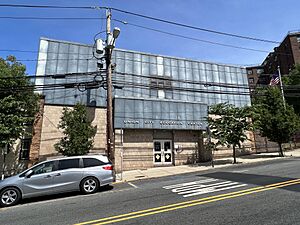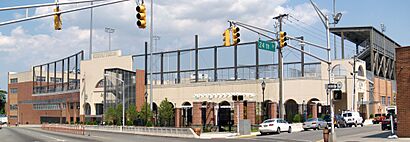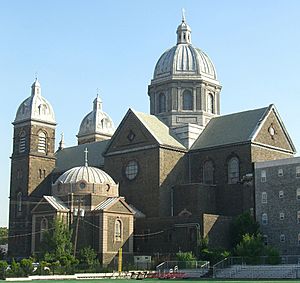Union City, New Jersey facts for kids
Quick facts for kids
Union City, New Jersey
|
||
|---|---|---|
|
City
|
||
| City of Union City | ||

Aerial shot of the city facing north, taken from its southern border at Washington Park
|
||
|
||
| Nickname(s):
"Embroidery Capital of the United States"
"Havana on the Hudson" "Little Havana on the Hudson" |
||
| Country | ||
| State | ||
| County | ||
| Incorporated | June 1, 1925 | |
| Government | ||
| • Type | Walsh Act | |
| • Body | Board of Commissioners | |
| Area | ||
| • Total | 1.29 sq mi (3.33 km2) | |
| • Land | 1.29 sq mi (3.33 km2) | |
| • Water | 0.00 sq mi (0.00 km2) 0.00% | |
| Area rank | 472nd of 565 in state 10th of 12 in county |
|
| Elevation | 190 ft (60 m) | |
| Population
(2020)
|
||
| • Total | 68,589 | |
| • Estimate
(2023)
|
64,462 | |
| • Rank | 590th in country (as of 2022) 18th of 565 in state 3rd of 12 in county |
|
| • Density | 53,293.7/sq mi (20,576.8/km2) | |
| • Density rank | 2nd of 565 in state 2nd of 12 in county |
|
| Time zone | UTC−05:00 (EST) | |
| • Summer (DST) | UTC−04:00 (Eastern (EDT)) | |
| ZIP Code |
07087
|
|
| Area code(s) | 201 | |
| FIPS code | 3401774630 | |
| GNIS feature ID | 0885424 | |
Union City is a city in the northern part of Hudson County, New Jersey. In 2020, it was the state's 18th most populated city, with 68,589 people. This was a small increase from 2010. Union City is also known as one of the most densely populated cities in the United States.
Union City became an official city on June 1, 1925. This happened when two towns, Union Hill and West Hoboken Township, joined together.
Two big groups of immigrants helped shape Union City. First came German speakers, then Spanish speakers. This is why the city has two special nicknames: "Embroidery Capital of the United States" and "Havana on the Hudson". These names show important parts of its history. Many people visit Union City every year to see its long-running passion play.
Union City is also famous for being the first place where Mallomars cookies were sold. It was also where the first lunch wagon was built. This helped New Jersey become known as the "diner capital of the world."
Contents
History of Union City
Early Beginnings and Borders
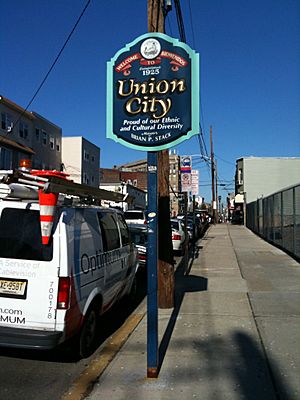
The land where Union City now stands was first home to the Lenape Native Americans. They lived in the large forests that Henry Hudson explored in the early 1600s. The Dutch later claimed this area and called it New Netherland.
The Dutch bought the land that would become Hudson County from the Hackensack tribe. Later, in 1658, the Dutch leader Peter Stuyvesant bought the land again. He ordered a fortified village to be built in 1660 to protect the area. This was the first permanent European settlement in New Jersey.
In 1664, the British took control from the Dutch. The area became part of Bergen Township. The northern part, called Bergen Woods, was settled later. Some Union City streets today are named after these early settlers. For example, Kerrigan Avenue is named after J. Kerrigan, who gave land for Saint Michael's Monastery.
The area remained mostly empty until the early 1800s. In 1840, New Jersey created Hudson County. Then, in 1843, it was divided into Old Bergen Township and North Bergen Township. Over time, North Bergen Township was split into many of the towns we know today.
West Hoboken became a township in 1861. Union Township was formed in 1864 by joining several small villages. The largest of these was Union Hill, which became the common name for the merged town. Finally, on June 1, 1925, West Hoboken and Union Hill merged to form Union City. One of the city's schools, Union Hill Middle School, still carries the old name.
Immigration and Local Industries
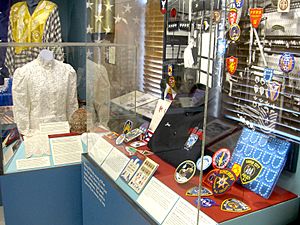
In the 1700s, Dutch and English traders first settled here. Later, many German immigrants moved from Manhattan looking for cheaper land. They were followed by Irish, Polish, Armenian, Syrian, Jewish, and Italian immigrants.
Germans began settling in what would become Union Hill in 1851. Along with Swiss and Austrian immigrants, they started the European-style lace making businesses. These businesses made Union City famous as the "embroidery capital of the United States." The city's seal even features a symbol of this industry. However, by the late 1990s, foreign competition caused the embroidery industry to decline. In 2014, the city dedicated "Embroidery Square" to remember this history.
As more immigrants arrived, the area became very diverse. By the early 1900s, Germans were the main group. Town meeting notes were even written in German. The city also developed a large trolley system. This was helped by the arrival of Irish and Italian immigrants.
Union City was also known for its entertainment. Theaters here hosted vaudeville and other shows. Famous performers like Fred Astaire and Harry Houdini appeared here. Comedian George Burns met his wife, Gracie Allen, at a theater in Union City.
The first Cubans came to Union City in the late 1940s. They were looking for jobs in the embroidery factories. After Fidel Castro took power in Cuba in 1962, many more Cubans moved to Union City. For many years, it had the largest Cuban population in the U.S. after Miami. This is why it's called "Little Havana on the Hudson." This immigration greatly changed the city's culture, including its food, music, and cigar-making.
In the 1960s, new buildings started to appear. The Troy Towers, a tall apartment complex, was built in 1966. In recent years, Union City has seen more new construction. This includes the city's first tall condominium building, The Thread, which opened in 2008. Its name honors the city's embroidery past.
Union City's Location
Union City covers about 1.29 square miles (3.33 km2) of land. It is part of the New York metropolitan area. The city sits on a ridge called the Hudson Palisades. From many streets, you can see views of nearby towns, the New York City skyline, and the New Jersey Meadowlands.
New Jersey Route 495 cuts through the city. This highway connects to the Lincoln Tunnel leading to New York City. Many street names were changed to numbers after this highway was built.
Union City's southern border is with Jersey City. Its northern border is with West New York at 49th Street. Kennedy Boulevard forms most of the western border with North Bergen. The eastern border with Weehawken runs along Park Avenue. The southern part of the city, once West Hoboken, is west of Hoboken.
Union City is unique because it is completely surrounded by other towns in Hudson County. These include Hoboken, Jersey City, North Bergen, Weehawken, and West New York.
People of Union City
| Historical population | |||
|---|---|---|---|
| Census | Pop. | %± | |
| 1870 | 4,640 | — | |
| 1880 | 5,849 | 26.1% | |
| 1890 | 10,643 | 82.0% | |
| 1900 | 15,187 | 42.7% | |
| 1910 | 21,023 | 38.4% | |
| 1920 | 20,651 | −1.8% | |
| 1930 | 58,659 | 184.0% | |
| 1940 | 56,173 | −4.2% | |
| 1950 | 55,537 | −1.1% | |
| 1960 | 52,180 | −6.0% | |
| 1970 | 57,305 | 9.8% | |
| 1980 | 55,593 | −3.0% | |
| 1990 | 58,012 | 4.4% | |
| 2000 | 67,088 | 15.6% | |
| 2010 | 66,455 | −0.9% | |
| 2020 | 68,589 | 3.2% | |
| 2023 (est.) | 64,462 | −3.0% | |
| Population sources: 1870–1920 1870 1880–1890 1890–1910 1870–1930 1940–2000 2000 2010 2020 |
|||
Population Changes Over Time
In the early 1900s, the towns that became Union City had a combined population of about 60,000. By the late 1900s, Union City was a community where many people worked in jobs that required physical labor.
In 2000, Union City had 67,088 people. It was the second most populated city in Hudson County. The city was very crowded, with about 52,977 people per square mile. This was about twice as dense as New York City as a whole.
By 2010, the population was 66,455. Union City remained one of the most densely populated cities in the U.S. In 2010, 84.71% of the population was Hispanic or Latino. This was the highest percentage in any New Jersey city.
In 2020, the population grew to 68,589. The city continues to be very diverse. Many residents speak Spanish at home.
Community and Work Life
As of 2019, about 71.5% of adults in Union City had finished high school or higher education. About 21.6% had a Bachelor's degree or more. Many residents work in New York City.
Union City has faced economic challenges. In the 2000s, studies showed it was among the most economically struggling places in the U.S. However, by 2019, the median household income was $48,992.
The Latino and Hispanic Community
Cuban immigration to Union City started slowly in the 1940s and 1950s. Jobs in embroidery factories attracted people. By 1955, the Cuban population was large enough that Fidel Castro even visited to raise money.
After the Cuban Revolution in 1959, many Cubans moved to Union City. This made it the city with the second-largest Cuban population in the U.S., after Miami. This led to its nickname, "Little Havana on the Hudson."
Over time, Cuban residents moved to other nearby towns. Today, West New York has a slightly higher percentage of Cubans. However, Union City still has the largest percentage of Hispanic residents in New Jersey, at 84.7% in 2010.
By the early 2000s, Union City became home to many other Latin American groups. These include Dominicans, Colombians, Ecuadorians, and Salvadorans. Even with fewer Cubans, New York City news often comes to Union City to talk to residents about Cuba-U.S. relations.
Parks and Fun Activities
Washington Park is a large park that sits on the border of Union City and Jersey City. It covers 22 acres. In the past, it hosted carnivals and Wild West shows, like Buffalo Bill's show in 1908. The park was developed in the 1930s. It features a cool stainless steel sculpture called Wave.
Reservoir Park opened in 2015. It is a quiet park built on the site of an old reservoir. The reservoir had not been used since 1996.
Shopping and Business

Bergenline Avenue is Union City's main shopping street. It is also a major shopping area for all of North Hudson County. It is one of the longest commercial streets in New Jersey. Many Cuban Americans call it La Avenida.
Bergenline Avenue runs through Union City and other nearby towns. It is sometimes called the "Miracle Mile." The busiest shopping part starts around 32nd Street. Bergenline Avenue is also used for local parades, like the annual Memorial Day Parade.

At the southern end of Union City, the main shopping area is around Summit Avenue and Transfer Station. This area was named "Transfer Station" because it was a place where people could switch between buses and trolley lines. A famous building here is a five-story, trapezoid-shaped brick building. It was built in 1910 as a bank. In 2023, the city planned to buy it to create affordable housing.
Transfer Station was also where the first lunch wagon was built in 1912. This helped New Jersey become famous for making diners. During World War II, this area was busy 24 hours a day with nightclubs.
Union City is also known for being the first place where Mallomars cookies were sold.
The city has an Urban Enterprise Zone (UEZ). This program helps businesses and improves the community. Shoppers in this zone can pay a lower sales tax rate. This helps encourage people to shop and businesses to invest in the area. The UEZ also helps fund city improvements and holiday decorations.
In 2018, Union City's unemployment rate was 4.5%.
City Government
Union City's City Hall is located at 3715 Palisade Avenue. It is the oldest city building in North Hudson. It was built in the 1890s as the town hall for Union Hill.
The city is run by a five-member Board of Commissioners. These members are elected by all voters in the city. After the election, each commissioner is in charge of a different city department. The mayor of Union City is also one of the commissioners.
As of 2024, the mayor of Union City is Brian P. Stack. He became mayor in 2000. The five commissioners manage different parts of the city. They are Mayor Brian P. Stack (Public Safety), Lucio P. Fernandez (Public Affairs), Wendy A. Grullon (Public Works), Maryury A. Martinetti (Revenue and Finance), and Celin J. Valdivia (Parks and Public Property). Their terms end in May 2026.
The city's budget in 2021 was $151 million. It stayed balanced even during the COVID-19 pandemic.
Public Safety
The Union City Police Department has over 200 officers. Nichelle Luster is the city's first female Police Chief.
In 1999, Union City and four other nearby cities combined their fire departments. This created the North Hudson Regional Fire and Rescue. Three of its fire stations are in Union City.
Getting Around Union City
As of 2010, Union City had about 41.67 miles of roads. Most of these are maintained by the city.
New Jersey Route 495 is the most important highway in Union City. It connects directly to the Lincoln Tunnel, which goes into New York City. Other major roads include U.S. Route 1/9 and New Jersey Route 3. Bergenline Avenue is also a main route for public transportation.
Public Transportation Options
The Bergenline Avenue station is part of the Hudson-Bergen Light Rail system. It is located near 49th Street.
New Jersey Transit bus service is available throughout Union City. These buses can take you to places in Hudson, Bergen, and Passaic counties. They also go to the Port Authority Bus Terminal in Midtown Manhattan.
You can also find privately run dollar vans, often called guagua in Spanish. These vans connect Union City to different parts of the New York metropolitan area.
Newark Liberty International Airport is about 12.5 miles south of Union City. LaGuardia Airport and John F. Kennedy Airport are also nearby in New York.
Education in Union City
In 2021, Union City had 14 public schools serving 11,893 students. As of 2023, there were 12,848 students.
A professor from the University of California, Berkeley, David L. Kirp, has praised Union City's education system. In his books, he noted how the schools help many poor, immigrant children succeed. He observed that Union City's schools have achievement scores close to the state average. In 2011, the high school graduation rate was 89.5 percent, which is higher than the national average. In 2012, 75 percent of graduates went on to college.
Public Schools
The Union City School District runs the public schools. They serve students from pre-kindergarten through twelfth grade. The district has 14 schools.
Some of the schools include:
- Eugenio Maria de Hostos Center for Early Childhood Education (PreK-K)
- Thomas A. Edison Elementary School (PreK–6)
- Sara Gilmore Academy School (1–8)
- Henry Hudson Elementary School (PreK–3)
- Jefferson Elementary School (PreK–4)
- Colin Powell Elementary School (K–5)
- Theodore Roosevelt School (K–6)
- Veteran's Memorial Elementary School (PreK–5)
- George Washington Elementary School (PreK–6)
- Robert Waters Elementary School (PreK–6)
- Emerson Middle School (6–8)
- Union Hill Middle School (7–8)
- José Martí STEM Academy (9–12)
- Union City High School (9–12)
Union City High School opened in September 2009. It was built where the old Roosevelt Stadium used to be. A special feature of the school is an athletic field on its second-floor roof. This new high school replaced the former Emerson High School and Union Hill High School, which became middle schools.
Hudson County Community College has a North Hudson Higher Education Center in Union City. It opened in September 2011. This center uses green technology like solar panels and rainwater tanks.
Colin Powell Elementary School opened in September 2012. Former Secretary of State Colin Powell visited the school in June 2013.
The Woodrow Wilson School received the Blue Ribbon School Award of Excellence in 2004–2005 and again in 2014–2015. This is a very high honor for American schools.
The Sarah M. Gilmore Elementary School opened in September 2017. It cost $29 million and serves 350 students.
The newest school is Union City Middle School, which started construction in September 2023. This six-story school will help with overcrowding. It is expected to open in Fall 2025. It will have special classrooms like a robotics lab and a hydroponics lab.
Private Schools
St. Francis Academy is a K-8 Catholic school. In 2013, it was recognized as a National Blue Ribbon School. Other private schools in Union City include two Islamic schools, Miftaahul Uloom Academy and Rising Star Academy, and a Jewish school, Mesivta Sanz.
Famous Places in Union City
The former Monastery and Church of Saint Michael the Archangel is a historic landmark. It is now called the Hudson Presbyterian Church. In 2002, José Martí Middle School and a public library branch were built on the monastery grounds. The middle school later became José Martí STEM Academy in 2019.
The Park Performing Arts Center was built in 1931. It has a large theater that seats 1,400 people. It hosts local and international artists and exhibitions.
Union City High School and Athletic Complex opened in 2009. It has a sports field on its second-floor roof. It also includes the Union City Performing Arts Center and a community health center.
Emerson Middle School opened in 1915 as West Hoboken High School. It was renamed Emerson High School when the towns merged. It became a middle school in 2009.
Union City has two Carnegie Libraries. These were funded by Andrew Carnegie. The first was built in 1903. The second, the main branch, was built in 1905. The 15th Street library is now the William V. Musto Cultural Center. It houses the Union City Museum of Art, the Union City Police Museum, and other cultural spaces.

Celia Cruz Park was dedicated in 2004 to honor Cuban-American salsa singer Celia Cruz. The park has a sidewalk star for Cruz and a mural. It is also part of Union City's "Walk of Fame," which honors other Latin entertainment stars.

9/11 Memorials Union City has memorials to honor the citizens who died in the September 11, 2001, terrorist attacks. Liberty Plaza was dedicated in 2007. Doric Park was rebuilt as Firefighters Memorial Park in 2009. It includes a public swimming pool and a memorial for fallen firefighters.
The Monastery of the Perpetual Rosary, also known as The Blue Chapel, was built between 1912 and 1914. It is considered a historic site.
Historical Markers Since 2009, Union City has placed historical markers to remember important people and places. These include markers for boxer Joe Jeanette, karate grandmaster Peter George Urban, and novelist Pietro di Donato.
COVID-19 Victims Memorial In March 2022, the city dedicated a memorial in Ellsworth Park. It honors those who died and suffered during the COVID-19 pandemic.
Media and Culture
Union City is part of the New York media market. Local news is covered by The Jersey Journal. El Especialito, a bilingual publication, is headquartered in Union City.
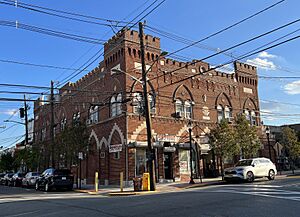
Some films have been set or filmed in Union City. These include Union City (1980) and Far from Heaven (2002). The 1989 film Bloodhounds of Broadway, starring Madonna, was partly filmed at a building on Summit Avenue.
Union City is part of an area called "NoHu," which is a hub for artists. Many artists from Latin America and other countries live here. Union City holds an annual Art Month, which includes festivals and art shows.
In 2009, Graciela Barreto was named Union City's first poet laureate. Ben Figueroa later took on this role. The city also has a City Historian and a Historical Committee.
In 2010, a gothic horror art film called Vampire in Union City was filmed entirely in the city. It was directed by Union City Commissioner Lucio Fernandez.
In April 2018, the documentary Union City, U.S.A. premiered. It tells the story of the city's history and culture.
The Multi-Arts Festival is an annual event held every May since 1981. It showcases artwork and musical performances by students and alumni. The William V. Musto Cultural Center also hosts many events, including concerts and film festivals.
In December 2010, the first Union City International Film Festival began. The city also created the Union City Plaza of the Arts. This plaza is a place for artists to show their work. It is located near other plazas that celebrate literature and music.
In June 2014, "Union City" became the city's official song. It was written by Phil Gallo and Mike Boldt. The song mentions local streets and landmarks.
Notable people
See also
 In Spanish: Union City (Nueva Jersey) para niños
In Spanish: Union City (Nueva Jersey) para niños



